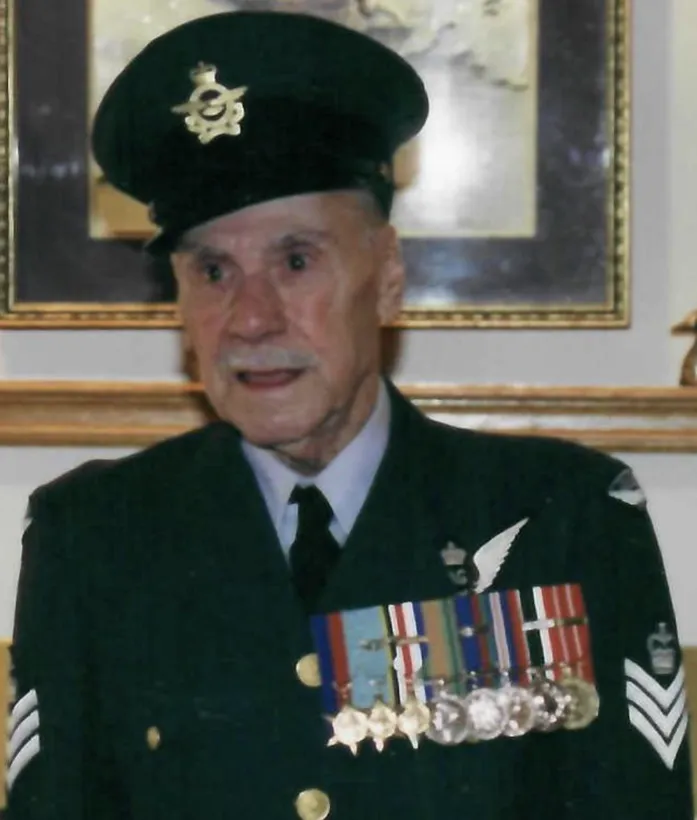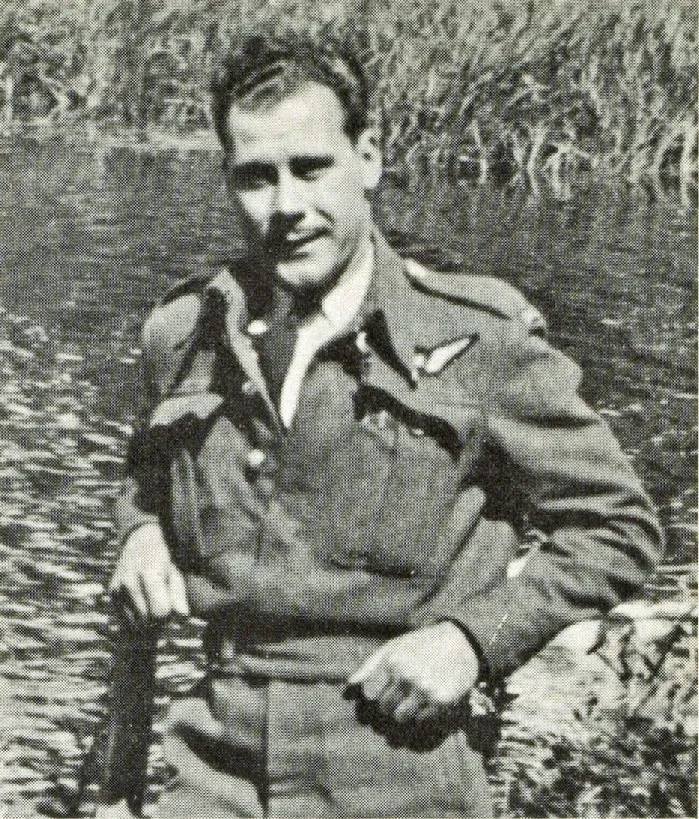
In mid-November 1944 Allied High Command assigned the B-25 Mitchells and A-20 Bostons of 137 and 139 Wings RAF the job of destroying the twin bridges at Venlo, Holland to stymie the German retreat. The two Wings attacked the bridges on seven occasions damaging the approaches and shifting the bridge spans, but not destroying them. The Germans quickly repaired the damage each time and continued moving troops and equipment.
Warrant Officer Joseph Francois Xavier Alfred Cote RCAF was a Wireless Operator/Air Gunner (WAG) in one of the 226 Squadron, 137 Wing Mitchells and was about to experience one of the most unique escapes of WWII.
Alfred had enlisted in the RCAF in January, 1940 in his home town of Ottawa, graduated from No. 3 Bombing & Gunnery School at MacDonald, Manitoba in November '42 and shipped overseas in March '43. He was posted to 21 Squadron RAF at Sculthorpe, Norfolk on 25 May 43, joining an existing crew flying Lockheed Venturas: Flight Lieutenant A.M. Alderton (Pilot), Flying Officer B. Chaiet (Navigator/Bomb Aimer), Flying Officer J. Reader (Air Gunner)
Their first op together, in Ventura Mk I serial AE790, on 27 Jul 43, was a raid on the coke ovens at Zeebrugge; they would fly a total of six ops ending 31 Aug 43, when 21 squadron started a conversion to de Havilland Mosquitoes. As there was no requirement for WAGs or Air Gunners in Mosquitoes, Alfred was posted to an Operational Training Unit as an instructor until October of 1944 when 226 Squadron came looking for Air Gunners.
Alfred, now a Warrant Officer (W/O), flew his first 226 operation, an attack on Venlo Bridge, 3 Nov 44 with crewmates: Flight Lieutenant Rimmel (Pilot), Flight Lieutenant Higgin (Observer), Flying Officer Applegarth (Wireless Operator/Air Gunner), Warrant Officer Fraser (Air Gunner).
He must have been serving as a Squadron Gunner, filling in for ill and otherwise missing regular crew gunners, as he flew three more ops, all with different crews and all against Venlo Bridge, until this one, 19 Nov 44.
180 Squadron's Fred Guest recalled of this attack: "On 19 Nov 44, our crew's 39th operation, there had been several formations ahead of us; we came in behind a formation of six Mitchells of 226 Squadron and the sky was full of flak all 'round it; we were about 20 seconds behind them on their bombing run; I was marveling at all the flak surrounding them and more than a little apprehensive (terrified) about flying into that same area in another few seconds. I saw an aircraft in the preceding formation take a direct hit and the starboard (right) wing came flying off; the aircraft went into a violent spin and I lost sight of it in a second or two. Now it was us on the bombing run and surrounded by flak bursts. When we completed our bombing run and set course for our base at Melsbroek, we were a pretty happy crew to have survived all that flak with only a few holes."
The aircraft that Fred saw get hit was 226 Sqn Mitchell II 'MQ-P' RAF serial FW146 (USAAF serial 42-87472) B-25D. That model had no tail guns, but had a Perspex observation dome at the end of the fuselage. In an RAF Mitchell crew, the Wireless Operator/Air Gunner (WAG) would lay prone with his head in the dome to spot any enemy aircraft approaching and, on bombing runs, to call out flak burst locations to aid the pilot via the intercom in evasive manoeuvres. The WAG would also man the ventral (lower) turret as required. The Air Gunner (AG) was positioned on a bicycle-type seat on the pedestal of the upper turret with his head and shoulders between armored plates; there was little room to turn his head; he had to traverse the turret in order to scan the skies around him.
That turret position in 'MQ-P' saved the life of WAG W/O Alfred Cote. There was no AG, but three WAGs, on this crew captained by Squadron Leader G. Campbell. Squadron Leaders often had extra crew in the form of new squadron members along for familiarization flights.
The flak hit that broke away the wing and threw the Mitchell into a spin also caused the tail section of the fuselage with gun turrets and empennage to break away, also into a spin. With Alfred trapped inside at his position on the upper turret pedestal, the spinning continued for several thousand feet before calming into a flutter, rather like an autumn leaf, for the last few thousand feet before coming to rest in a Dutch orchard.
All of Alfred's crewmates were killed. They are buried in the Jonkerbos War Cemetery at Gelderland, Netherlands: Squadron Leader G. Campbell DFC (Pilot) RAFVR, Flying Officer D.G. Farquar DFC (Nav/B) RAFVR (of Great Neck, NY, USA), Flying Officer J.L. Halliday (Special Observer) [GEE?] RAFVR (of Notting Hill, London, England), Pilot Officer W. Hodson (WAG) RAFVR, Pilot Officer W.E. Osmonde (WAG) RAAF (of Goulburn, NSW, Australia)
W/O Cote was assisted from the remains of the tail section by a Dutch farmer who had watched the wreckage spiral into his orchard. Incredibly, after a fall of 11,500 feet, Alfred's worst injury was a broken leg; combined with other injuries, he required immediate attention so the farmer had to contact German authorities. Alfred was taken by horse-drawn cart and canal barge to a facility where his leg was splinted, but without being set. After three weeks he was removed to a POW camp near Dusseldorf, followed by several more moves until an Australian doctor, also a prisoner of war, was allowed to re-break and properly set the leg and put it in traction to heal properly. When he was well enough to move Cote was returned to the prison camp's general population. There are no records of where Cote was interned; it was likely Stalag VIG at Bergisch-Neustadt and its associated Lazarett (hospital).
Alfred was liberated by US Army forces in April 1945 and flown back to England to be reunited with his wife Winifred (Howell), whom he had married in 1943 in Newcastle, and his daughter Carolyne, born in Sep 1944. They moved to Canada and Alfred's hometown Ottawa, arriving in mid-June, 1945 to live with Alfred's mother, Ida Cote./p>
Condensed from 'Survival Miracle From 11,500 Feet' by David Poissant


 Ottawa, Ontario
Ottawa, Ontario MI-9 Post Prisoner of War Interview
MI-9 Post Prisoner of War Interview www.findagrave.com
www.findagrave.com Library and Archives Canada Service Files (may not exist)
Library and Archives Canada Service Files (may not exist)
 Mitchell Bomber
Mitchell Bomber Wikipedia Mitchell Bomber
Wikipedia Mitchell Bomber Harold A Skaarup Web Page
Harold A Skaarup Web Page